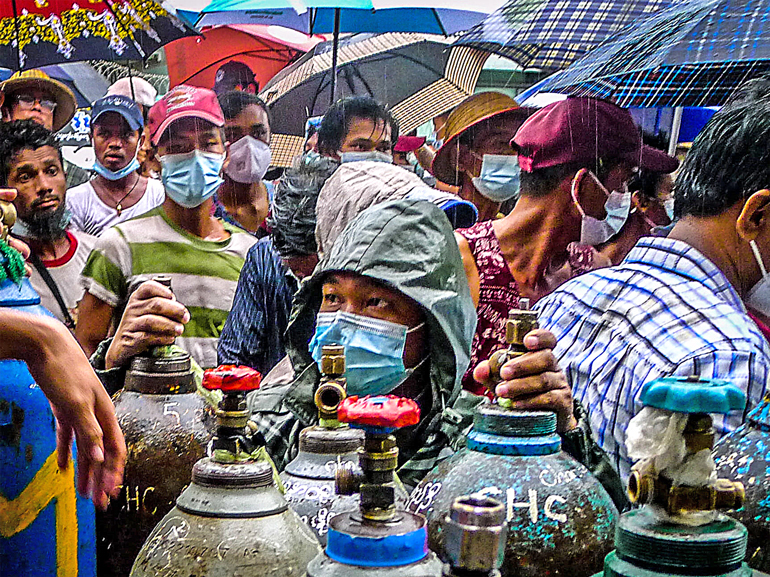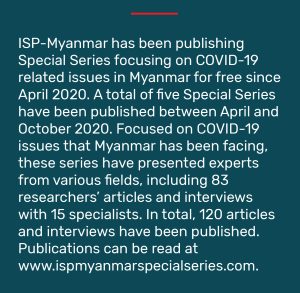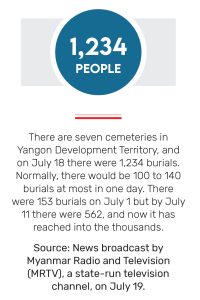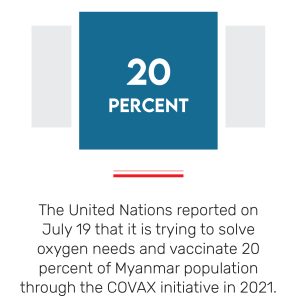(This article is a translation of the original Burmese language version that ISP-Myanmar posted on its Facebook page on July 20, 2021.)

Introduction
According to the official laboratory records of the military council, the Delta and Alpha variants in the third wave of COVID-19 have infected four in every ten people. If the infection rate on June 27 is used as a baseline, the infection has increased more than 580 times within 20 days. The fatality rate has also skyrocketed to over 3,200 times in 20 days. Percentage-wise, the infection rate has increased to 39.12 percent on July 17, and the fatality rate has reached a new record of about 4.24 percent based on the infection rate. These rates are just the tip of the iceberg compared to the actual fatality and infection rates happening on the ground.

If this infection rate continues, almost half of the population could be infected and thousands could be dead in the coming weeks. Since the rate of infection has skyrocketed and the new variants cannot be neglected, Myanmar’s crisis has become a danger not only domestically but also regionally. This situation could quickly escalate from a pandemic crisis to the wider loss of human security, including food shortages, failure of the rule of law, and regional instability. Myanmar is now in an emergency state in which humanitarian efforts must be conducted in order to prevent further catastrophe. Domestically, a Whole-of-Society approach–the cooperation between individuals, families, groups, and organizations across every sector, class, and field–should be implemented to solve every general crisis stemming from this disease.
Moreover, it is time to accept that this is a big struggle: it is stubborn to think it can be solved only by domestic efforts, and the crisis requires urgent requests for humanitarian assistance from the international community.

Three Needs and Five Sectors
COVID-19 prevention and control measures are connected with socio-economic conditions, the rule of law, and politics, and there are three big needs from the perspective of public health. These are: (1) diagnostic ability, (2) ability to treat disease, and (3) vaccination capabilities. Myanmar is among countries in the worst position to address these three needs.
In Myanmar, there are five sectors which handle the COVID-19 crisis:
- Public Health Sector
- Private Sector
- Community Sector, including civil society organizations and volunteers, religious groups and leaders, and local philanthropists and entrepreneurs
- EAO-controlled Sector
- Individual/Family Coping
These five sectors are not just overloaded; some are almost destroyed and some are already gone. These three needs are addressed largely by these five sectors and the cooperation between them has reportedly failed.
Not Having a Government that People Trust and Support
Myanmar is not the only country that has to face the COVID-19 third wave with Delta and Alpha variants. Neighboring countries, like Thailand and Indonesia from the ASEAN region, and western countries have experienced high infection and fatality rates. Despite going through a similar experience, there is a difference in the amount of adverse effects and the ability to confront these challenges. In addition to the advantages that a strong public health sector offers, such as diagnostic ability and the provision of treatment and vaccinations, the existence of a legitimate political system and a government with good administration and management is crucial for public health issues. With this kind of political system and government in place, health education campaigns that focus on public trust and participation can have some success despite the challenges on the ground.
Although there were criticisms regarding COVID-19 prevention and control measures conducted under State Counsellor Aung San Suu Kyi’s NLD government, it is notable that health education preventive treatment measures were conducted with high public trust. This trust helped to mobilize material, human, and financial resources across the five sectors, as well as resources from international assistance.
Such good conditions mentioned above have almost disappeared since the military coup in February 2021. The military council, which is undoubtedly the least trusted body to lead the country, is facing public protests and the legitimacy of its rule is strongly denied by Myanmar people.
More than 60 health workers including doctors and nurses have been arrested for leading a movement not to cooperate with the military council and for making the military council unable to rule, and about 595 health workers who participated in the civil disobedience movement have been issued arrest warrants. The public health system, which was already weak, reached its weakest point because of such pressures.
Moreover, the military council has restricted the operations of businesses which produce health-related materials (e.g., factories that produce oxygen) and private business leaders importing health-related materials, caused shortages that deepen all three needs.
Likewise, the system which trained more than 50,000 volunteers under the NLD government has also been destroyed. Many people who had volunteered and led community-based activities joined the anti-coup activities, causing some of them to have been arrested or killed.


Many people hold the belief that “people only have people,” and that they must find their own solutions when dealing with the impacts of the pandemic. However, even these efforts are threatened by the actions of the military council, which has reportedly arrested private individuals who donate to COVID-19 relief organizations and provide independent medical assistance.
In the Ethnic Armed Organizations-controlled sector, the three needs of the pandemic have been partially addressed with help from some neighboring countries, particularly in the northeastern and northern regions. However, this help is not enough for the whole EAOs-controlled region, and further, the quality of the solution (e.g. vaccine type) may also be lacking. Worse yet, it is harder to maintain the situation since the number of IDPs are increasing due to air strikes conducted by the military council and intense clashes between the military council and EAOs.
In Myanmar, poverty at the individual and family level has increased during the first and second waves of COVID-19. Although the World Bank predicted before the coup that Myanmar’s economy will grow by 6 percent this year, it reported after the coup that economic development will be reduced by 10 percent. Other economic organizations have warned that it could be reduced by as much as 20 percent. The World Food Programme reported that more than 3.4 percent of the Myanmar population could face food insecurity in the next 3 to 6 months. The situation of families with low income has worsened since 2020 and it is reported that almost half of the country’s population (48.2 percent) may fall below the poverty line during the worst periods of this political crisis. These predictions were published before the COVID-19 third wave and now the situation could be worse. In a situation where there are many low-income households, extensive unemployment, and the inability to withdraw personal savings deposited in the bank, it is devastating for people to battle COVID-19 on their own.
As a result, the third wave of the COVID-19, in which people have been battling the highly contagious delta and alpha variants, has added more stress to the already weak public health system, and the military council has no support from the public and the international community. Thus, this crisis must be recognized as an emergency situation that is creating a national security problem and humanitarian crisis which can impact the region. The Whole-of-Society Approach must be taken to meet the needs of this emergency. The United Nations organization based in Myanmar reported on July 19 that it is trying to solve oxygen needs and vaccinate 20 percent of the Myanmar population through the COVAX initiative in 2021. Such help, and similar help from other countries and international organizations, should be welcomed and appreciated. But it is obvious that such help is not enough to address the COVID-19 third wave crisis and the needs that Myanmar is facing just by looking at the COVID-19 infection and fatality rates and the numbers concerning the three needs.
Recommendations
- Myanmar needs to recognize and accept that this crisis cannot be solved domestically and dutifully request urgent international humanitarian assistance. Moreover, requests through bilateral relations are not enough, and Myanmar needs to request assistance from various international bodies. With regard to international assistance, the five-point consensus on Myanmar, released on April 24 after the ASEAN special summit, can be used as a guide.
The fourth point of the five-point consensus states that “ASEAN will provide humanitarian assistance through the ASEAN Humanitarian Assistance Coordinating Center for Humanitarian Assistance (AHA)”. As agreed to by the chair of the military council, he must dutifully ask for humanitarian assistance through the AHA. Whether the military council chair asks or not, the National Unity Government, the EAOs, and other stakeholders must request humanitarian intervention from the AHA and the international community to save 52 million people from the pandemic.
- There could be a shortage of resources at the AHA Center since many ASEAN countries are also facing the COVID-19 third wave, and the AHA Center itself could have limitations to its operations. Thus, the AHA Center should try to get support from: international immunization programs such as Gavi, COVAX, and AMC with help from the United Nations Security Council member states, including China, India, the United Kingdom, and the United States, which supported ASEAN’s efforts to address the situation in Myanmar; the agencies under the control of the United Nations (especially the World Food Programme); and countries that are trying to help solve the situation in Myanmar such as Japan, South Korea, and Norway. The AHA Center should appoint a Humanitarian Special Envoy to provide humanitarian assistance to Myanmar by selecting an expert from an ASEAN country or connecting with the UN Office for the Coordination of Humanitarian Affairs.
- The AHA Center needs to form a Rapid Assessment Team to understand the true extent of Myanmar’s COVID-19 emergency and propose solutions, and it should send the team to Myanmar as soon as possible.
- The military must also announce pardons for all detained health workers and must withdraw arrest warrants. Health workers must have the ability to participate in any of five sectors in which they can have a positive impact on the COVID-19 emergency.
- The military council must guarantee that it will not prevent, restrict, cut, or abuse cross-border assistance; it must act with transparency and accountability toward this remote response, and it should make a humanitarian pledge that it will allow international humanitarian assistance and all stakeholders involved in Myanmar’s COVID-19 response to operate smoothly.
Conclusion
Only if everyone comes together to solve the pandemic that Myanmar is currently facing will the country be able to lessen the physical and mental trauma that will be experienced for generations. Humanitarian crises could stem from politics or could become worse because of politics. Therefore, the solution to the humanitarian crisis should eventually transition from a humanitarian emergency to more sustained solutions for the political crisis. Good examples of humanitarian response can be seen in Aceh after the 2004 tsunami and in Nepal after 2015 earthquake. Even if political solutions cannot be found immediately, all stakeholders should follow the recommendations mentioned above quickly since these will provide major support in saving people’s lives during the COVID-19 third wave in Myanmar.



